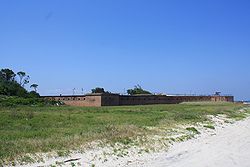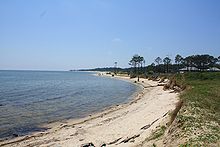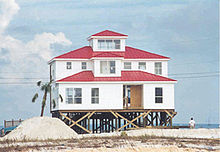- Dauphin Island, Alabama
-
Dauphin Island — Town — Town of Dauphin Island Fort Gaines on the eastern end of Dauphin Island Location in Mobile County and the state of Alabama Coordinates: 30°15′23″N 88°07′31″W / 30.25639°N 88.12528°WCoordinates: 30°15′23″N 88°07′31″W / 30.25639°N 88.12528°W[1] Country United States State Alabama County Mobile Area - Total 166.1 sq mi (430.2 km2) - Land 6.2 sq mi (16.1 km2) - Water 159.9 sq mi (414.1 km2) Elevation[2] 7 ft (2 m) Population (2000) - Total 1,371 - Density 8.3/sq mi (3.2/km2) Time zone Central Standard Time (CST) (UTC-6) - Summer (DST) Central Daylight Time (CDT) (UTC-5) ZIP code 36528 Area code(s) 251 FIPS code 01-19744 GNIS feature ID 0117086 Website TownOfDauphinIsland.org Dauphin Island is a town in Mobile County, Alabama (U.S.), on a barrier island also named Dauphin Island (split by the Katrina Cut), at the Gulf of Mexico. The population was 1,371 at the 2000 census. The town is included in the Mobile metropolitan statistical area. The island (originally named "Massacre Island") was renamed for Louis XIV's great-grandson and heir, the Dauphin.
The Gulf of Mexico is to the south of the island; the Mississippi Sound and Mobile Bay are to the north. The island's eastern end helps to define the mouth of Mobile Bay. The eastern, wider portion of the island, is shaded by thick stands of pine trees, but the narrow, western part of the island features scrub growth and few trees.
Dauphin Island is home to Fort Gaines, Dauphin Island Sea Lab, The Estuarium public aquarium, the Dauphin Island Airport, boat ramps, a large public pier, historics sites, several restaurants, new condominium developments, and numerous private homes. Beaches attract tourism, and fishing is a popular activity in the waters around the island. The island is connected to the mainland by the Gordon Persons Bridge.
Although the island has several bird sanctuaries, the main one is the 164-acre (66 ha) Audubon Bird Sanctuary. Dauphin Island is the first landfall encountered by many birds as they migrate north from South America, and as a consequence many species can be found resting there before continuing their journey.
Contents
History
Serpentine shell middens, perhaps 1500 years old, attest to at least seasonal occupation by the Native American Mound Builder culture. Shell Mound Park, along the Island's northern shore, is administered by Alabama Marine Resources Division.
In 1519, the Spanish explorer Alonzo Pineda was the first documented European to visit, staying long enough to map the island with remarkable accuracy.
The island's French history began on January 31, 1699, when the explorer Pierre Le Moyne, sieur d'Iberville, one of the founders of French Louisiana, arrived at Mobile Bay, and anchored near the island on his way to explore the mouth of the Mississippi River. D'Iberville named it "Isle Du Massacre" (Massacre Island) because of a large pile of human skeletons discovered there. The gruesome site turned out to be a simple burial mound which had been broken open by a hurricane, not a massacre site, but the name stuck.[3]
D'Iberville later decided to locate a port for Fort Louis de La Louisiane on the island due to abundant timber, reliable supply of fresh water, and a deep-water harbor. The settlement consisted of a fort, a chapel, government-owned warehouses, and residences.[3]
Inside Shell Mound Park
The island served as a major trading depot, unloading goods from Saint-Domingue (Haiti), Mexico, Cuba and France, and collecting furs in a short-lived fur trade. Mobile Bay itself, before a channel was dredged, was too shallow, and its sand bars too shifting and treacherous, for ocean-going vessels to travel up the bay and Mobile River to Fort Louis de La Louisiane. So, smaller boats carried cargo within Mobile Bay to Dauphin Island.
Fort Gaines on the eastern tip of the island was built between 1821 and 1848. It was occupied by Confederate forces in 1861, and captured by Federal troops during the Battle of Mobile Bay. The phrase, "Damn the torpedoes, full speed ahead," was spoken by U. S. Admiral David Farragut just a few hundred yards from Dauphin Island's shore.
The first Sand Island Light, authorized in 1834, was replaced by a structure 150 feet (46 m) high, at a cost of $35,000, that was dynamited by Confederate forces. The present lighthouse (1873; in use until 1970), has been placed on the National Register of Historic Places. Its ownership was recently transferred from the Department of Interior to the Town of Dauphin Island.
Geography
According to the U.S. Census Bureau, the town has a total area of 166.1 square miles (430.1 km2), of which, 6.2 square miles (16.1 km2) of it is land and 159.9 square miles (414.1 km2) of it (96.27%) is water.
Demographics
As of the census[4] of 2000, there were 1,371 people,(but falling in the 2010 census to 1238) 601 households, and 418 families residing in the town. The population density was 221.2 people per square mile (85.4/km2). There were 1,691 housing units at an average density of 272.9 per square mile (105.3/km2). The racial makeup of the town was 96.43% White, 0.44% Black or African American, 1.60% Native American, 0.58% Asian, and 0.95% from two or more races. Hispanic or Latino of any race were 0.95% of the population.
There were 601 households out of which 21.6% had children under the age of 18 living with them, 61.7% were married couples living together, 5.0% had a female householder with no husband present, and 30.3% were non-families. 23.0% of all households were made up of individuals and 6.3% had someone living alone who was 65 years of age or older. The average household size was 2.28 and the average family size was 2.66.
In the town the population was spread out with 17.4% under the age of 18, 7.4% from 18 to 24, 25.7% from 25 to 44, 33.3% from 45 to 64, and 16.2% who were 65 years of age or older. The median age was 45 years. For every 100 females there were 111.6 males. For every 100 females age 18 and over, there were 114.0 males.
The median income for a household in the town was $44,219, and the median income for a family was $50,476. Males had a median income of $35,179 versus $24,250 for females. The per capita income for the town was $22,552. About 6.0% of families and 9.2% of the population were below the poverty line, including 6.7% of those under age 18 and 5.4% of those age 65 or over.
Education
The town is served by the Mobile County Public School System. It has one public school, Dauphin Island Elementary School. Middle school students go on to Alba Middle School in Bayou La Batre and Alma Bryant High School in the Irvington section of unincorporated Mobile County.
The Dauphin Island Sea Lab is located on the east end of the island on grounds formerly occupied by the 693rd Radar Squadron, Dauphin Island Air Force Station, US Air Force, and is home to the Marine Environmental Sciences Consortium.[5]
Dauphin Island's Crest
On the top is the historic Ft Gaines with two cannons (one facing North and one facing South) which represents Dauphin Island's part in America's Civil War of the 1800s. The boat is a shrimping vessel which represents the livelihood of many of the residents of the island and the Dolphin is a mammal seen quite often in the Gulf of Mexico and Mobile bay waters surrounding the Island. The birds are Pelicans which are numerous around the island and the entire Gulf coast. The Fleur de Lis represents France (1699–1764). The sailing ship is a Spanish Galleon (1781–1813). Both countries were very influential in settling the area.
Hurricanes
Over the centuries, many hurricanes have struck the island. Some recent storms include:
- In 1979, Hurricane Frederic (September 12, 1979) destroyed the bridge to the mainland, which had been opened in 1955.
- In 1985, Hurricane Elena brought wind gusts of over 130 mph (210 km/h) to the island.
- In 1997, Hurricane Danny caused extensive flooding on the east end of the island.
- In 1998, Hurricane Georges destroyed 41 houses on the island.
- In 2004, Hurricane Ivan caused nearly one-fourth of the island to be covered with approximately two feet of water.
- On August 29, 2005, Hurricane Katrina brought damage to parts of Dauphin Island. Some homes on the west end of the island were destroyed, and the Katrina Cut was formed as a channel splitting off the western part. However, most areas of the Central and East end of the island experienced little flooding from the storm surge. Unlike typical storm surge effects on a mainland coastline and affected waterways, on an island the surge moves around and over the land mass without the mounding up of water experienced on the mainland.
The approach road to the island fared better than expected. The damage to most East End beach front homes was limited to decks, stairs and storage buildings. In DeSoto Landing, a gated gulf-front subdivision on Dauphin Island, the main homes had no water entering the homes unless a window or roof system failed; many avoided surge waters entirely. Damage was limited due to Sand Island (Pelican Island), a large sandbar south of DeSoto Landing which broke the force of battering waves.
An oil drilling platform grounded near the island as the hurricane passed by.[6] It was identified by its owners, Diamond Offshore Drilling Inc., as the Ocean Warwick, pushed nearly 60 miles (97 km) from its original location by the hurricane.[7]
Tourist attractions
The old walled Fort Gaines is on the east end of Dauphin Island. A ferry from nearby Fort Morgan in Gulf Shores brings both vehicles and pedestrians to the island. One of the closest attractions to the ferry dock is The Estuarium, a fresh- and saltwater aquarium highlighting species native to Alabama.
See also
References
- ^ "US Gazetteer files: 2010, 2000, and 1990". United States Census Bureau. 2011-02-12. http://www.census.gov/geo/www/gazetteer/gazette.html. Retrieved 2011-04-23.
- ^ "Dauphin Island". Geographic Names Information System, U.S. Geological Survey. http://geonames.usgs.gov/pls/gnispublic/f?p=gnispq:3:::NO::P3_FID:0117086. Retrieved 2009-07-26..
- ^ a b "The coinage for Massacre Island, 1699!". Shirepost.com. http://www.shirepost.com/FrenchMassacre.html. Retrieved 2007-05-09.
- ^ "American FactFinder". United States Census Bureau. http://factfinder.census.gov. Retrieved 2008-01-31.
- ^ Records of United States Air Force Commands, Activities, and Organizations U.S. National Archives
- ^ Recorder.ca[dead link]
- ^ Oilonline.com[dead link]
External links
- Town of Dauphin Island, official website
- Dauphin Island Property Owners Association
- Island Mullet Wrapper - Dauphin Island news and information
- Dauphin Island news and information
- Still in Harm's Way, NOW on PBS, Video on Dauphin Island
- Dauphin Island Park and Beach Board Dauphin Island, Alabama
- Dauphin Island Foundation
- Historic Fort Gaines on Dauphin Island, Alabama
Municipalities and communities of Mobile County, Alabama County seat: Mobile Cities Bayou La Batre | Chickasaw | Citronelle | Creola | Mobile | Prichard | Saraland | Satsuma | Semmes
Towns Dauphin Island | Mount Vernon
CDPs Axis | Belle Fontaine | Bucks | Calvert | Grand Bay | Theodore | Tillmans Corner
Unincorporated
communitiesGhost town Categories:- Barrier islands of Alabama
- Places affected by Hurricane Katrina
- Populated places in Mobile County, Alabama
- Towns in Alabama
- Populated coastal places in Alabama
- Populated places established in 1702
Wikimedia Foundation. 2010.







